Someone once said that employees are a company’s greatest asset and if you want to gain a competitive advantage, you need to attract and retain the best of the best. This is still true today across all industries, and it is especially true in the spa industry. But how do you attract the best of the best salespeople, and how do you ensure your people not only have the tools they need to succeed, but are motivated to do so? Invest in a sound compensation strategy.
According to findings published in Harvard Business Review, U.S. companies alone spend more than $800 billion on the development, revision, and implementation of their salesforce compensation plans, making it the number one marketing expense for American businesses. Though most companies know incentives are what drives sales, every companies’ plan looks slightly different. Some businesses offer flat commission rates so sales costs rise and fall with revenues. Others use bonuses to encourage hitting certain quotas while others yet use a salary plus commission-based plan.
In this article, we’ll describe the various types of sales compensation plans
Salary vs. Commission
It’s no secret that good salespeople are driven by performance-based rewards. However, with the perception that commission employees are too expensive, many dealers are hesitant to offer a commission-based pay.
The reality though is that one of the few ways to significantly improve sales volume is to pay commission. Al Hulme, an industry veteran and Regional Manager for Bullfrog Spas in Ontario, states, “Dealers get caught up in how they can make a [compensation] transition without short-changing the business. They’re afraid they can’t afford to pay commission.” He argues just the opposite is true—spa retailers can’t afford not to pay commission.
... spa retailers can’t afford not to pay commission.
As Hulme points out, retailers need to realize that commission is actually less risky and a better motivator since it’s contingent on sales: If a salesperson doesn’t close any spa sales, he or she won’t be paid.
Hulme urges spa retailers to look at a commission-based salesperson as an investment to the company rather than a business risk. In fact, chances are a dealer can recruit higher quality employees who cost them less as a result of increased sales volume and gross profit per hot tub sold. With this thought in mind, let’s explore how paying a salesperson commission greatly benefits the business’s net earnings.
The Numbers Say It All
Let’s get right to the meat of the argument (assuming you like a good cut of beef). This example uses fictional names and slightly rounded numbers for simplicity but is based on a real-world situation and helps show the impact a commission-based compensation plan can have on business performance .
Dealership 1 – Straight Salary Model
In our first example, we have a smaller dealer (we’ll call it Shirley’s Spas) who has 3 employees and pays each a straight salary. The staff aren’t typically hired as dedicated salespeople, but as generalists expected to perform a variety of different functions within the dealership, including sales. Because the dealer wants to be fair, all 3 of their employees are compensated similarly.
With a straight annual salary averaging $45K and several different responsibilities to think about, each generalist employee at Shirley’s closes an average 2 out of every 10 customers that enter the showroom at an average gross profit of $3K per unit sold. This totals about 25 hot tubs per year and $75K in total sales per employee. Doing the math, that nets the dealer $30K per year, per employee (less than their salary).
This dealer is selling $225K total, netting $90K, and paying $135K in salary. Things are tight and growth is stagnant. The Shirley’s owner is forced to contribute significantly to sales and management at their business.
Dealership 2 – Base Plus Commission Model
For our second example, we’ll look at Stanley’s Spas (not their real name), who also has 3 employees and operates in a similar market in the same region as Shirley’s. However, at Stanley’s, 1 of the 3 employees is hired as a dedicated salesperson and paid a base salary plus a commission. Stanley’s owner wanted to test that the secret to hiring quality salespeople was finding only the most money-hungry applicants out there. The motto he applied to this sales hire was, “If he or she doesn’t aspire to own a Porsche, then don’t hire them.”
Under the mindset that such an investment has a greater chance at generating larger returns, Stanley’s owner hired an experienced salesman, along with 2 generalist employees who make a straight salary averaging $45K each. The compensation arrangement for the superstar salesperson is a base pay of $2K per month plus 20% of gross profits. Though a bit harder to manage (kind of a self-serving personality), this employee is highly motivated by how much he can sell and how much profit he can build into each sale.
And here’s how the numbers work out. In his first year, the new salesperson closed 8 out of 10 customers for a total of 100 hot tubs with a gross profit of $4K per unit. This translated into paying the new sales hire $104K, but the business earned a net $296K. With the other two straight salary employees each selling their standard 30 spas annually and $75K in total sales, Stanley’s employees generated $550K in sales, $356K in net, and spent $194K in compensation.
That’s right, the Stanley’s Spas owner made $356K in net profit, or $266K more than Shirley’s, with the addition of just one base plus commission salesperson. The next year the increase in cash flow allowed the owner at Stanley’s to reinvest into marketing the business, improving employee benefits, and building a higher quality sales team (less the underperformers). They are growing.
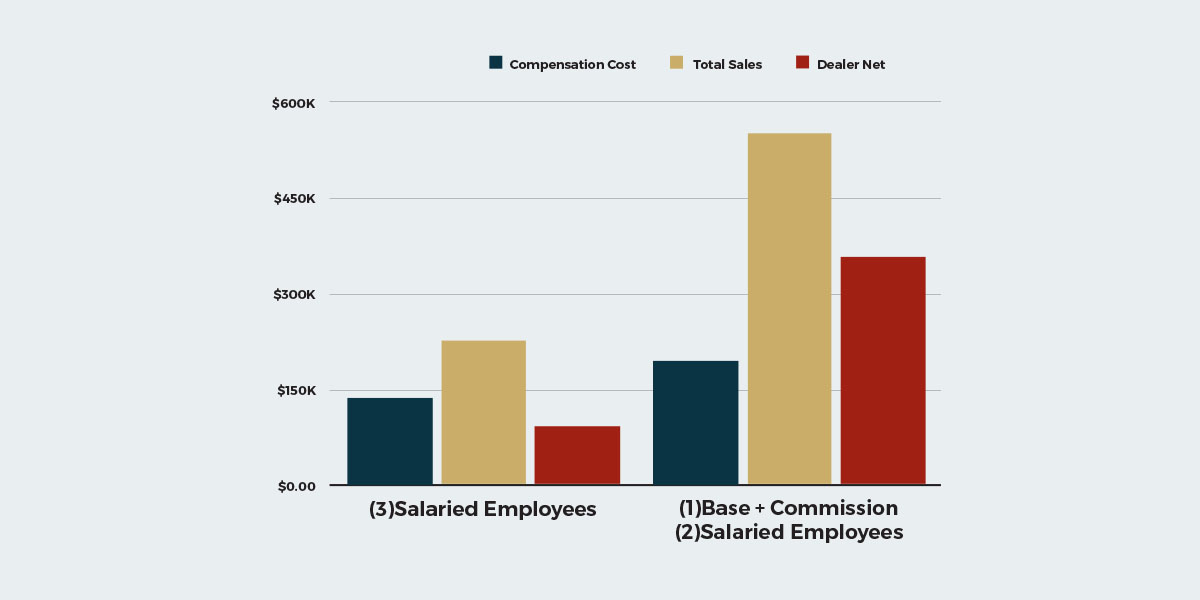
Example of a dealership with all salaried people vs. similar dealership with 1 commissioned employee.
A simple change in compensation strategy made all of this happen and proved a testament to the “you get what you pay for” concept when it comes to quality sales staff.
Ultimately, commission-centered strategies rely on salespeople to be the closers, freeing up the dealer... so he/she can serve as the more productive traffic generator.
Ultimately, commission-centered strategies rely on salespeople to be the closers, freeing up the dealer from being a sales hand so he/she can serve as the more productive traffic generator. At the end of the day, this is how the best hot tub retailers boost their store’s earnings as well as their own.
So Which Commission-Based Compensation Plan Should You Use?
Hopefully, we’ve established that basing pay on commission is really the only way to go in this business. But when it comes to the right or best commission plan, there isn’t a one-size-fits-all strategy. A compensation plan should be as unique as your business and staff are, and sometimes a business finds it better to apply more than one. What works for one retailer may not work for another as sales staffs vary in both personality and size. So the best way to get the most from each team member will need to vary according to employee position and personal motivation, along with the dealer’s perspective on risk. Essentially, it comes down to where a retailer decides to land on the spectrum of risk management vs. employee motivation.
Here’s a breakdown of the more common types of the pros and cons of various commission plans.
Straight Commission
Straight commission is a broad term; but in this case, it is intended to mean the kind of compensation plan that pays a salesperson a percentage of each sale only. With this strategy, the salesperson receives no salary or wage besides their commissions. The belief behind a straight commission plan is that all employees will be highly motivated to close more sales since their entire paycheck depends on it. This kind of compensation program could get tricky in areas with significant seasonality trends where the salesforce does not earn as much during slower months, as it could lead to a disgruntled and discouraged staff.
Pros:
- Earning potential will attract salespeople who are great closers
- Easy for dealers to compare sales costs against sales and track performance
- Removes liability to provide a salary that reduces overhead costs
Cons:
- Creates an every-man-for-himself mentality and potentially disconnects employees, making it harder to create a unified team
- Staff won’t want to be bothered with other duties that won’t lead them to a sale, i.e., customer service
- Sales teams may become too pushy or only want to sell high-ticket items
Base Plus Commission
Base plus commission is one of the most common forms of compensation plans for hot tub retailers. In this setup, the sales team receives base wages, whether that be a yearly salary or an hourly rate, plus a percentage of the sales they close. The commission percentage can vary depending on the type of sale, deal amount, or any other conditions you would like to impose. In order to succeed with a base plus salary compensation plan, employees are motivated by one simple principle: The more they close, the more they earn.
Pros:
- Security from this compensation plan helps attract a higher quality salesforce
- Base pay helps limit seasonality issues, keeping employees happy and reducing employee turnover
- Added commission incentivizes employees to establish more long-term deals and focus on value-added products rather than just bigger-ticket items
- Base salary improves sales team’s willingness to help perform other duties outside of selling, such as customer service and store maintenance
Cons:
- Still requires paying a salary regardless of sales
- Can add complexity to financials and make monthly sales tracking more difficult
Draw Against Commission with Minimum
A draw against commission plan is less conventional than other compensation strategies. Under this program, a salesperson is paid a predetermined amount at the beginning of the pay period. This amount, also known as draw, is then deducted from their commission at the end of the pay period. A salesperson needs to sell enough spas to make up for the predetermined amount; once that is paid, he can keep the remainder of his commission. This type of plan can be highly motivating for a sales team while giving them a greater sense of financial security—at the very least, they’ll need to earn the amount of their initial draw for the month. A draw against commission plan is often used to attract a higher level salesperson, such as a manager or lead position.
Pros:
- Employees feel adequately compensated since they receive pay upfront, allowing them to make do until they receive their full commission
- Protects retail business since the initial investment is more likely to be paid back (rather than paying out a flat salary regardless of sales)
Cons:
- Can get complicated and cause friction between dealer and the salesperson
- If a salesperson does not make enough in commission to cover their draw, then technically the dealer is out the initial amount until enough sales are made
Flat Fee for a Spa Sale
Offering employees a flat fee for a spa sale is one of the most straightforward types of commission plans. Simply stated, the salesperson receives a predetermined amount on every spa they sell either on its own or with a base. This type of plan is extremely flexible and can be applied to a variety of employees, not just the sales team. A flat fee creates a high level of incentive and can be used as a bonus for hourly employees.
Pros:
- Minimizes upfront compensation expenses while reducing HR costs
- Can be applied to employees already on payroll
Cons:
- May not be as motivating as a profits-based commission-only plan, especially when it comes to the upsell
- Might not attract higher level salespeople
Profit Sharing
Profit sharing is also a nonconventional type of plan in which the salesperson’s pay correlates to how well the company is performing as a whole. When the company thrives, the salesperson is paid well, typically a bonus percentage of gross sales that may or may not be tiered. Profit sharing allows for flexibility in terms of what employees are offered as an incentive.
This compensation program works best for Andy Mossing of Mossing Spas in Toledo, Ohio.
“I am a big fan of the employee-owned business. I feel like tying employees into the performance of the company is great and it gives the employees something to strive for. We do profit sharing and I do some bonuses based on the bottom line, especially with sales and service managers. I want them to stress efficiency and doing things right the first time. There does have to be a lot of trust and honesty between the employees and owner if an owner is going to bonus the bottom line…I believe bonusing the bottom line empowers employees to find ways to save the company money.”
Pros:
- Employee may feel they are a valued asset and more of an equal to upper management
- Provides a cushion for the dealer when sales are slow
- Sales team works more efficiently and takes a long-term view as it strives to make the company better as a whole, not just individual numbers
- Creates a unified team
Cons:
- Often associated with a higher turnover rate (employees may not feel their commission is fair or paid often enough)
- Generally only works for retailers with stable and consistent revenue throughout the year (to minimize risk of damaging company morale)
The key comes back to recruiting the right people. And no matter which commission plan(s) is/are used, the dealer must be clear about expectations to help eliminate any friction among employees. Here’s the bottom line: By providing the sales team a commission, a spa retailer will establish that selling spas is important at your company, motivating all staff from the get-go.
Make Benefits Part of the Plan
Today’s salespeople don’t just want money—though money is a huge motivational factor. Salespeople, like all employees, also want benefits. But which benefits most motivate salespersons? Surprisingly, salespeople are just as motivated by the traditional benefits, such as healthcare, vision, and dental, as full-time employees and managers. According to a Fractl survey of 2,000 U.S. workers, employees are more motivated by the following benefits than anything else (except, of course, money):
- Better health, vision, and dental (88%)
- More flexible hours (88%)
- More work from home options (80%)
- Better vacation time (80%)
- Unlimited vacation (68%)
Aside from better health benefits, which was the most commonly cited incentive, it is clear that most U.S. workers these days simply want a better work-life balance. It is becoming more and more evident that overworked employees underperform and the more a person works doesn’t necessarily correlate with improved results. People need to spend quality time with family, pursue personal interests and enjoy time to themselves so that they can reset their batteries and show up to work Monday morning refreshed and ready to close more deals.
Shift Salespersons’ Performance Curve Upward
Though there is no one right or wrong type of compensation plan, if you hope to yield the most amount of benefits, it is crucial that you understand your sales team and what drives each individual to succeed. It often means offering more than one compensation plan among your sales staff.
If you want to boost the number of sales your spa business sees each month, quarter or year, you need to revamp your compensation plan so it includes incentives that makes each salesperson, no matter where on the performance curve he or she falls, respond positively. Though this type of compensation plan will require more research, time, and effort on your part, it will all pay off in the end when you are able to keep your salesforce happy and sales numbers high.


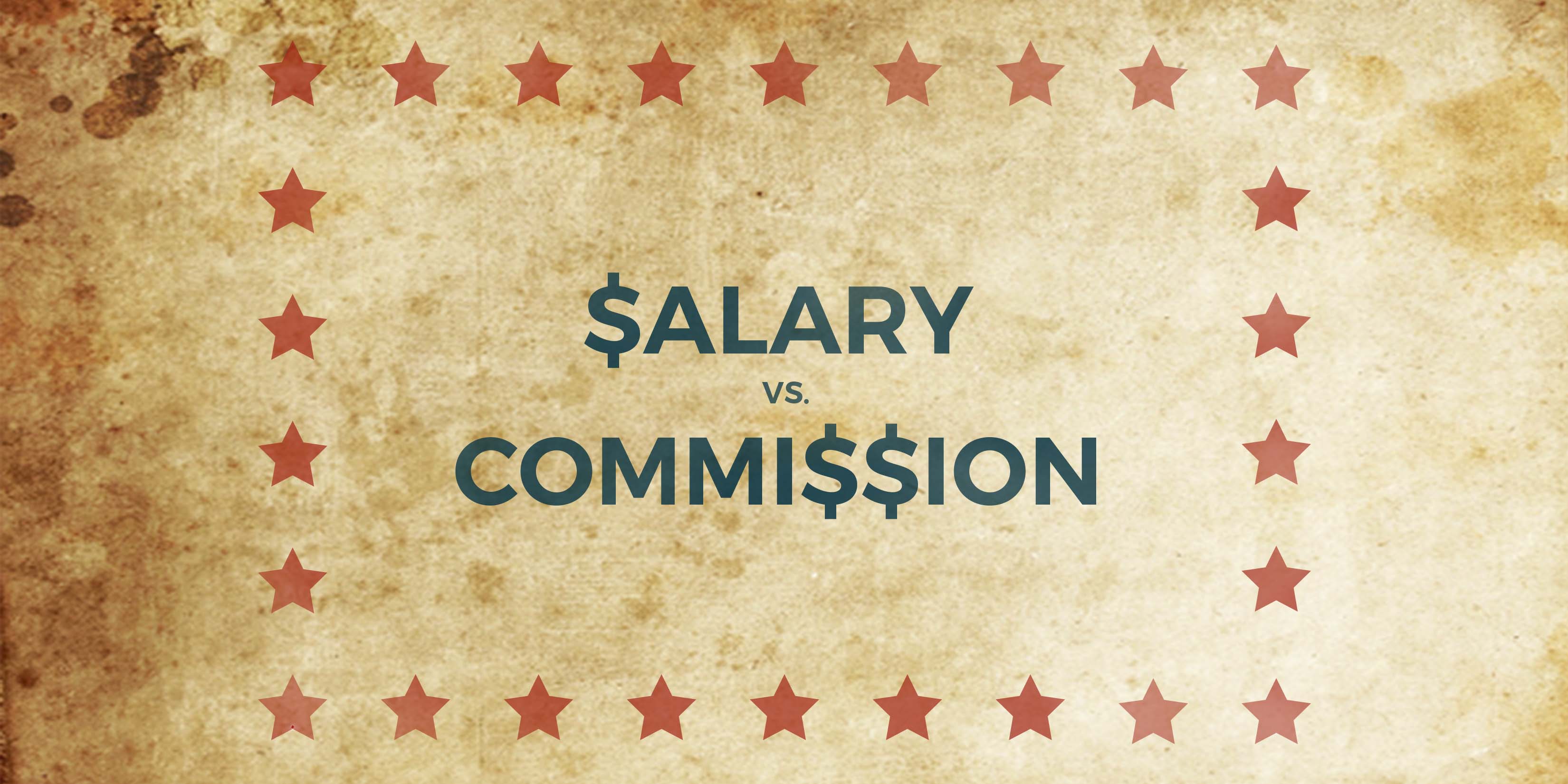

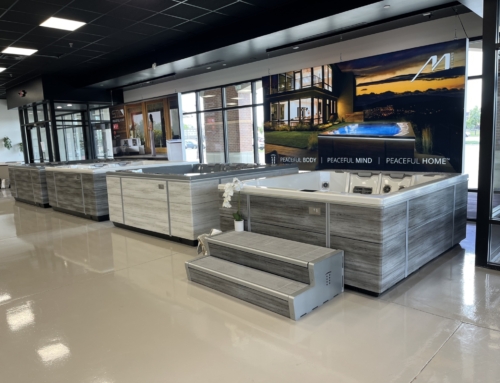
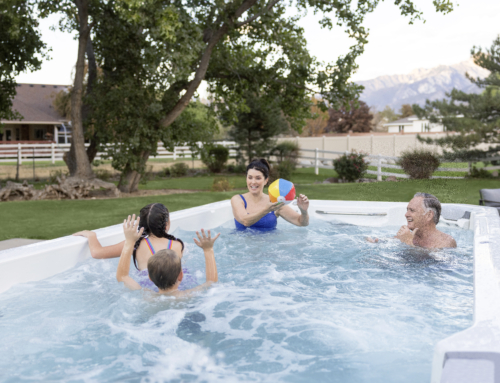
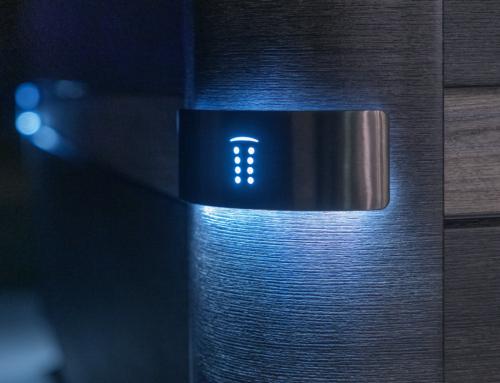

Totally agree with commissioned salespeople bring the way ho go I’ll add some thoughts. Commission rates should start on the low side and work there way up as sales increase. This concept has the salesperson continuously striving for a new goal. If they know their commission will increase as they reach a goal of, let’s say 10 Spas, their commission will go up, the salesperson is not only motivated to get their next sale but also reach that next level of commission.